 |
|
|
| (Information by Mick Baker, with additional information by Peter Kessler, from The Viking Discovery of America The Excavation of a Norse Settlement in L'Anse Aux Meadows, Newfoundland, Helge Ingstad & Anne Stine Ingstad (Breakwater, 2000), and from External Links: Publications (Eleanor Rosamund Barraclough), and New horizons at L'Anse aux Meadows (PNAS, 2019), and Success of sky-polarimetric Viking navigation (The Royal Society), and_L'Anse aux Meadows and Vinland: An Abandoned Experiment_, Birgitta Linderoth Wallace (part of Contact, Continuity, and Collapse: The Norse Colonization of the North Atlantic, James H Barrett, Brepols NV, 2003, available separately as a PDF download via ResearchGate) and Solar storm confirms Vikings settled in North America (The Guardian).) |
|
|
| 986 - c.1020 |
Bjarni Herjólfsson accidentally discovers the Newfoundland coastline after being blown off course during his voyage from Norway to Greenland. Norse navigation generally uses coastlines, the stars, and sundials which have been calibrated to show the direction of the North Pole, but any interruption in sunlight would disrupt that. 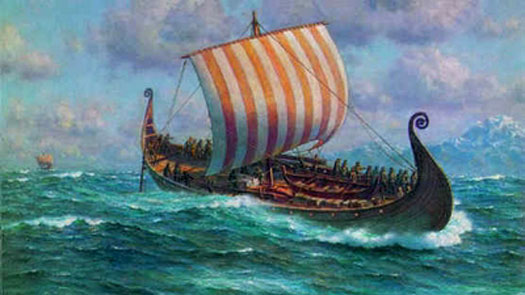 Bjarni Herjólfsson could have been acclaimed by history as the first European to discover the Americas, if only he'd landed instead of continuing his voyage to Greenland Bjarni Herjólfsson could have been acclaimed by history as the first European to discover the Americas, if only he'd landed instead of continuing his voyage to Greenland |
|
| Because he does not want to delay his journey he does not go ashore to investigate the newly-sighted lands. Instead, he completes the voyage to Greenland where he remains until the death of his father. Then he returns to Norway where he relates his tale of discovery, around AD 1000. He repeats it again upon a return to Greenland, which inspires Leif Erikson to attempt to retrace his steps. |
|
|
| 1021 - 1025? |
Leif Erikson |
Son of Eirik the Red of Greenland. Colony founder. |
| 1021 |
Eight timber-framed buildings covered in sod stand on a terrace above a peat bog and stream at the northern tip of Canada's island of Newfoundland: the L'Anse aux Meadows settlement. In 2021 a new dating technique reveals the precise date at which Leif Erikson's Viking settlement is founded in Vinland, by this group which has travelled from Greenland using the very same ship as Bjarni Herjólfsson and retracing his steps. 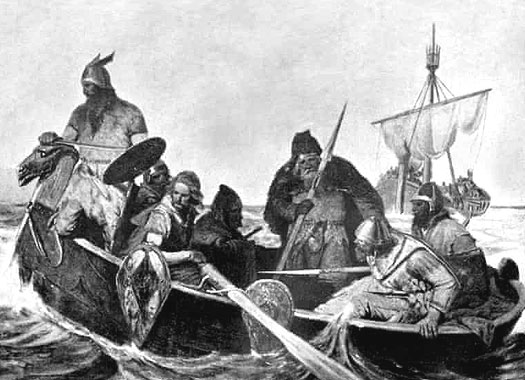 Leif Erikson's name is preserved by the Icelandic sagas which record the relatively short-lived Viking settlement of Newfoundland Leif Erikson's name is preserved by the Icelandic sagas which record the relatively short-lived Viking settlement of Newfoundland |
|
The new dating method relies on the fact that solar storms produce a distinctive radiocarbon signal in a tree's annual growth rings. It is known there had been a significant solar storm in 992 involving a burst of high-energy cosmic rays from the sun. The trees which are cut down for the Viking dwellings have twenty-nine additional rings after that date, meaning that they are felled in 1021. Leif Erickson is the offspring of Eirik the Red, a leading figure in the Norse settlement of Greenland. Eirik himself is the son of Thorvald Asvaldsson of Jadar, who had been exiled from Norway in the 870s for murder. He had gone on to settle on the newly-discovered island of Iceland, providing the first link in the chain which would lead to Vinland. The earliest use of 'Red Indian' to denote the Native Americans they meet in Vinland certainly post-dates the Norse settlers of Newfoundland. The people they encounter would be the Beothuk, whom they called skrælings and who are know to daub themselves in red paint, thereby further emphasising their skin colour. 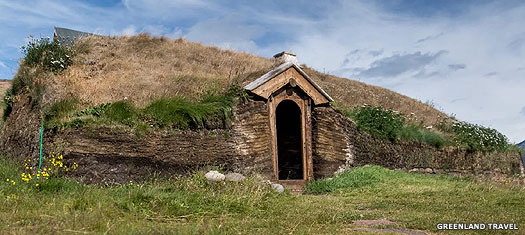 Norse occupation on Greenland itself was not always as smooth as it could be, as evidenced by this abandoned dwelling, so the farther-flung outpost of Vinland may have been beyond contemporary means to support it Norse occupation on Greenland itself was not always as smooth as it could be, as evidenced by this abandoned dwelling, so the farther-flung outpost of Vinland may have been beyond contemporary means to support it |
|
|
| But the Norsemen are unlikely to expect any '[Indians](../KingListsFarEast/IndiaStates.htm#Chalukyas Western)' here even if they do know what they are. They attack and kill the skrælings they meet, but are attacked in return by a larger force. Leif's brother, Thorvald, is killed after being struck by an arrow. Having been in Vinland for around four years (and Thorvald for about three, according to the Saga of the Greenlanders), the main party decides to return home to Greenland. |
|
|
| 1026/27 - 1028? |
Thorfinn Karlsefni |
Brother-in-law. Renewed the colony, perhaps two years later. |
| c.1026 - 1027? |
The Saga of the Greenlanders provides no firm dating, but a rough timeline can be calculated. Another brother of Leif Erikson's is Thorstein. He marries Gudrid, the widow of a ship's captain who had been rescued by Leif. He leads a third expedition to Vinland to bring home Thorvald's body but loses his way and spends much of the summer wandering the Atlantic. Following an over-wintering on Greenland he dies of disease. 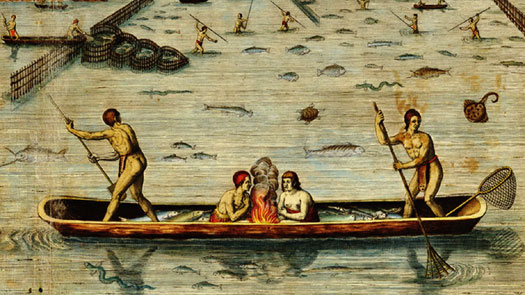 This unspecified group of native Americans is illustrated in this sixteenth century engraving, showing them fishing and probably marking them out as a coastal people This unspecified group of native Americans is illustrated in this sixteenth century engraving, showing them fishing and probably marking them out as a coastal people |
|
| Gudrid remarries, to an Icelander named Thorfinn Karlsefni. The two lead a major expedition back to Vinland, taking livestock with them. This time relations with the Native Americans are peaceful, with trade links being established. Late in the year (by which time it must be 1027 or even later), a misunderstanding with the natives leads to the settlement being attacked. This time the Vikings are prepared, with a strong defensive position ready so that they only suffer minor casualties. |
|
|
| 1028 - 1029? |
Freydis |
Dau of Eric the Red. Sister to Leif. Returned to Greenland. |
| c.1028 - 1029? |
Thorfinn and Gudrid return to Greenland with a vessel laden with grapes and/or berries of various types, along with hides. Freydis, daughter of Eric the Red (presumably Leif's sister), leads another expedition in the same summer, with two Icelanders and their followers. 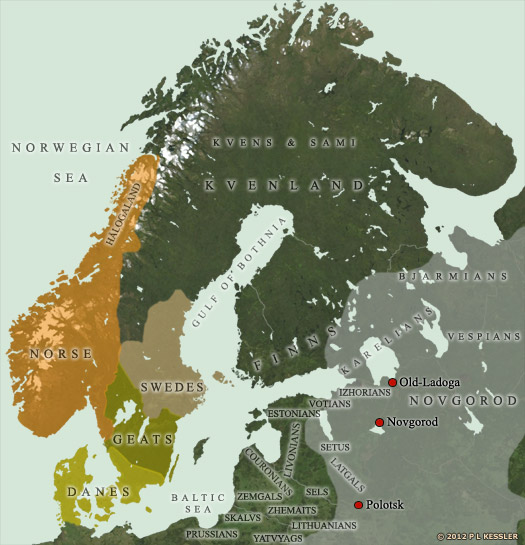 This map of Scandinavia around AD 1000 shows the extent of the Norwegian kingdom at this time in relation to its Scandinavian neighbours (click or tap on map to view full sized) This map of Scandinavia around AD 1000 shows the extent of the Norwegian kingdom at this time in relation to its Scandinavian neighbours (click or tap on map to view full sized) |
|
| Upon landfall the Icelanders apparently show disrespect to Leif's dwelling, so Freydis banishes them from the settlement. That autumn Freydis is seemingly behind a deliberate misunderstanding which results in the murder of the entire Icelander party in their sleep, including five women. The expedition returns to Greenland the following summer, again laden with produce. Leif discovers the truth behind the Icelander-killings, and no further expeditions are recorded in the Saga of the Greenlanders. |
|
|
| c.1030 - 1347 |
Further voyages to Vinland are recorded however, some of them over a century later, but records are extremely patchy regarding any results. One vessel disappears entirely in 1121, never to be heard of again. One vessel in 1347 is blown off course before making landfall on Iceland. It contains a full shipment of timber, the probability being that this has been harvested from the Vinland area. 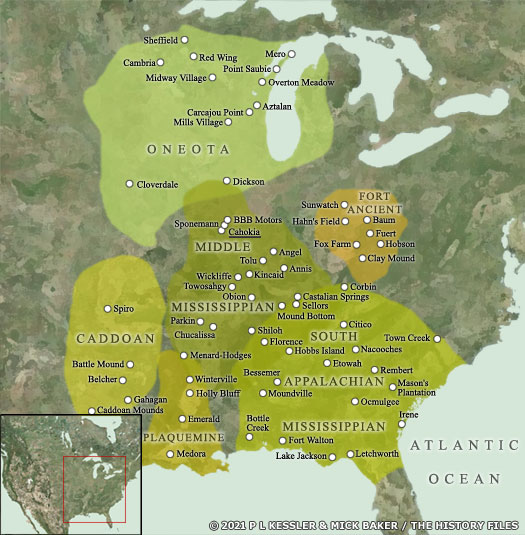 The Mississippian culture and its related neighbours essentially had Cahokia as their capital, this being the largest pre-Columbian settlement to the north of the Aztec empire (click or tap on map to view full sized) The Mississippian culture and its related neighbours essentially had Cahokia as their capital, this being the largest pre-Columbian settlement to the north of the Aztec empire (click or tap on map to view full sized) |
|
| Could the Union of Denmark and Norway in 1380 change the trading conditions for Iceland and Greenland so that Vinland is no longer a priority and is eventually abandoned and forgotten? To date, no modern scholars have arrived at any firm consensus. Possibly by coincidence, this is the same period in which North America's Late Mississippian culture is in steep decline, also eventually disappearing until it is rediscovered by modern archaeologists. |
|
|
 |
|
|

 Bjarni Herjólfsson could have been acclaimed by history as the first European to discover the Americas, if only he'd landed instead of continuing his voyage to Greenland
Bjarni Herjólfsson could have been acclaimed by history as the first European to discover the Americas, if only he'd landed instead of continuing his voyage to Greenland Leif Erikson's name is preserved by the Icelandic sagas which record the relatively short-lived Viking settlement of Newfoundland
Leif Erikson's name is preserved by the Icelandic sagas which record the relatively short-lived Viking settlement of Newfoundland Norse occupation on Greenland itself was not always as smooth as it could be, as evidenced by this abandoned dwelling, so the farther-flung outpost of Vinland may have been beyond contemporary means to support it
Norse occupation on Greenland itself was not always as smooth as it could be, as evidenced by this abandoned dwelling, so the farther-flung outpost of Vinland may have been beyond contemporary means to support it This unspecified group of native Americans is illustrated in this sixteenth century engraving, showing them fishing and probably marking them out as a coastal people
This unspecified group of native Americans is illustrated in this sixteenth century engraving, showing them fishing and probably marking them out as a coastal people This map of Scandinavia around AD 1000 shows the extent of the Norwegian kingdom at this time in relation to its Scandinavian neighbours (click or tap on map to view full sized)
This map of Scandinavia around AD 1000 shows the extent of the Norwegian kingdom at this time in relation to its Scandinavian neighbours (click or tap on map to view full sized) The Mississippian culture and its related neighbours essentially had Cahokia as their capital, this being the largest pre-Columbian settlement to the north of the Aztec empire (click or tap on map to view full sized)
The Mississippian culture and its related neighbours essentially had Cahokia as their capital, this being the largest pre-Columbian settlement to the north of the Aztec empire (click or tap on map to view full sized)